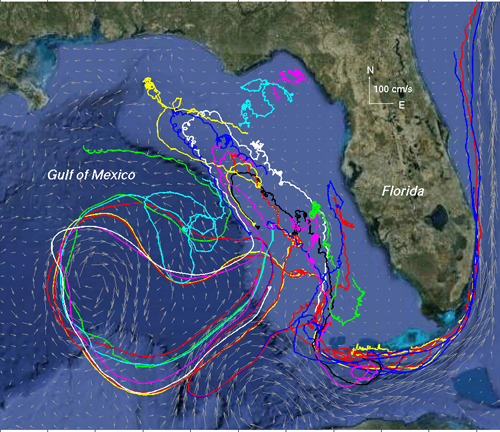Satellite-Tracked Drifters in the Eastern Gulf of Mexico
| Beginning in May 2010, and in response to the Deepwater Horizon oil spill [Liu et al., 2011a], the Ocean Circulation Group (OCG) at the USF College of Marine Science (CMS-USF) has deployed surface drifters in and around the Loop Current and on the West Florida Continental Shelf (WFS). The intent of these deployments are to assist in monitoring the evolution of the Loop Current and its eddies [Liu et al., 2011b] and how they are interacting with the West Florida Shelf and to observe surface water movements on the WFS itself. This information is also useful in gauging the behaviors of hydrodynamic models used in tracking the oil spill [Liu and Weisberg, 2011]. Six drifters were initially deployed during the R/V Bellows 19-24 May cruise in a joint effort between the OCG and Optical Oceanography Laboratory at the CMS-USF, FDEP, USCG, and FWC/FWRI. Three additional drifters were deployed during the R/V Weatherbird II 2-14 June cruise by the CMS-USF Ocean Circulation Group assisted by the Florida Institute of Technology (FIT). During the most recent R/V Weatherbird II cruise, 22-25 June, nine additional drifters were deployed in a joint effort by the OCG-CMS-USF and the Woods Hole Oceanographic Institution (WHOI).
These drifter data can be downloaded at USF/OCG data server. A skill score for trajectory model performance evaluation using drifter data. This skill score is particularly useful when the number of drifters is very limited, or the drifter trajectories are sparsely distributed in space. References:
|
|
See a movie of all USF drifters recently deployed in the
eastern Gulf of Mexico.
See a movie of
all currently active drifters recently deployed in the eastern Gulf of Mexico.
See a movie of all drifters (including inactive) recently deployed in the eastern Gulf of Mexico.
Back to Yonggang Liu's homepage


